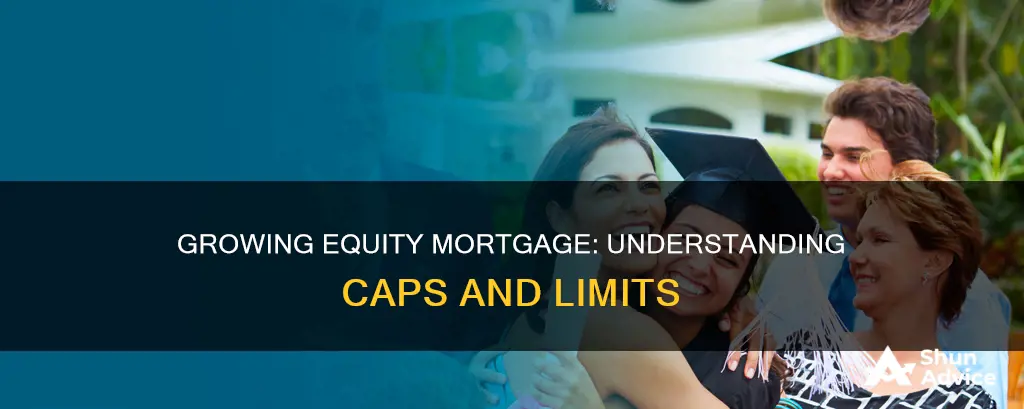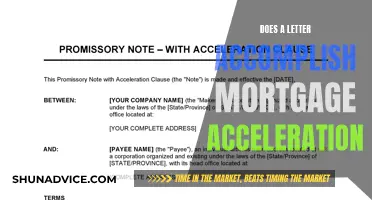
A growing equity mortgage (GEM) is a type of fixed-rate mortgage with a unique repayment structure. GEMs are designed for borrowers who expect their earnings to increase over time and are typically offered to first-time homebuyers or young families who cannot afford high initial payments. The defining feature of a growing equity mortgage is that monthly payments increase gradually over time, allowing borrowers to build equity in their homes faster than with a conventional loan. While this structure can lead to significant interest savings and accelerated repayment, it also carries the risk of financial strain if income does not keep pace with the rising payments. So, does this type of mortgage have a cap, and if so, what are its implications?
| Characteristics | Values |
|---|---|
| Interest rate | Fixed |
| Monthly payments | Increase over time |
| Down payment | Low |
| Eligibility | First-time home buyers, young families, moderate-income buyers, borrowers with high potential for earnings growth |
| Repayment period | 15-20 years |
| Payment increase | 1-5% per year |
| Insurance | FHA insurance available |
| Risk | Market volatility, limited flexibility |
What You'll Learn
- GEM loans are available to borrowers with a high potential for earnings growth
- GEMs have a repayment period of 15-20 years
- GEMs are insured through the FHA, protecting lenders against loan default
- GEMs have a fixed interest rate but monthly payments increase over time
- GEMs are eligible for insurance under Section 203(b) for one- to four-family homes

GEM loans are available to borrowers with a high potential for earnings growth
GEM loans, or Growing Equity Mortgages, are available to borrowers with a high potential for earnings growth. This type of mortgage is designed for those who may not qualify for conventional mortgages. GEMs are a variation on a fixed-rate mortgage, where monthly payments increase over time according to a set schedule, typically at 5% per year. The interest rate on the loan remains fixed, and there is no negative amortization. The additional principal payments are pre-scheduled and allow the borrower to pay off their mortgage faster, build home equity more quickly, and benefit from lower total interest payments.
The Federal Housing Administration (FHA) offers GEM loans to borrowers with a high potential for earnings growth. FHA insurance protects lenders against borrower defaults, covering a range of scenarios, including new purchases, refinancing, and property rehabilitation. FHA Growing Equity Mortgages are available to anyone who anticipates their earnings to increase and intends to use the mortgaged property as their primary residence. These loans are often targeted at first-time homebuyers or young families who may not be in a position to meet the upfront and monthly costs of homeownership.
To qualify for an FHA Growing Equity Mortgage, borrowers must have a minimum FICO score of 580 to take advantage of the low down payment option of 3.5%. If the credit score is below 580, the down payment requirement increases to 10%. It is important to note that, as payment amounts increase annually, homeowners must experience corresponding salary growth or an enhanced ability to meet the larger payments.
GEM loans are a unique variant of fixed-rate mortgages, offering a predetermined schedule of gradually increasing payment amounts. This distinguishes them from traditional fixed-rate mortgages, where payments remain constant throughout the loan term. By opting for a GEM loan, borrowers can benefit from accelerated principal repayment and overall interest savings.
Fannie Mae Mortgage Note: Grace Period Explained
You may want to see also

GEMs have a repayment period of 15-20 years
A growing equity mortgage (GEM) is a variation on a fixed-rate mortgage where additional principal payments are pre-scheduled and increase over time, typically by 5% a year. The Federal Housing Administration (FHA) offers GEM loans to borrowers who have a high potential for earnings growth that can cover progressively increasing payments. The FHA will insure the lender against losses. GEMs are also available to first-time homebuyers or young families who may not qualify for conventional mortgages.
GEMs have a repayment period of 15 to 20 years. During the initial years, the payments are low and calculated similarly to a 30-year mortgage. After the initial period, the payments rise yearly, and the extra amount is added to the principal. As the borrower pays down the principal, they build equity in their home faster, which also decreases the loan term. The rise in payments is typically between 1% and 5%, and this percentage is set during the loan agreement.
The flexibility of GEMs allows homeowners to increase their monthly payments incrementally over time. This means that homeowners can adjust their payments based on their financial situation and capacity, ensuring that they can afford the higher payments as their income grows. This can be particularly advantageous in a rising real estate market, as homeowners can potentially build equity more quickly and benefit from the appreciation of their property.
However, it is important to consider the risks associated with GEMs. As your equity grows, your mortgage balance and monthly payments also increase. This could strain your budget, so it is crucial to ensure you have the financial capacity to handle the higher payments in the future. Another risk is the impact of market volatility on your home's value. If the real estate market experiences a downturn, the value of your home may decrease, leading to a slower growth rate in your equity.
Grantee vs Mortgage Owner: Who Has the Upper Hand?
You may want to see also

GEMs are insured through the FHA, protecting lenders against loan default
A growing-equity mortgage (GEM) is a variation on a fixed-rate mortgage where additional principal payments are pre-scheduled and increase over time, typically by 5% a year. GEMs are insured through the Federal Housing Administration (FHA), which is a US government body. The FHA insures loans made by private lenders, protecting them against losses and default by the borrower.
GEMs are available to borrowers who may not qualify for conventional mortgages. The FHA offers GEM loans to borrowers with a high potential for earnings growth that can cover progressively increasing payments. The FHA's insurance enables lenders to have the confidence to extend loans to these borrowers. The insurance also allows borrowers to put down a smaller down payment, starting at 3.5% for those with a credit score of 580 or above. If the credit score is between 500 and 579, the down payment requirement is 10%.
FHA loans are designed to help low- to moderate-income families, particularly first-time homebuyers, attain homeownership. The federal government insurance provided by the FHA gives banks the confidence to lend to homebuyers with low credit scores and small down payments. The insurance also keeps initial costs down for borrowers. The borrower pays an insurance premium of 0.5% on declining balances for the lender's protection. In return, they receive a careful appraisal by an FHA inspector and a lower interest rate than the lender might have offered without the protection.
FHA loans are also available for refinancing, rehabilitation, and the purchase of properties, including condominiums, cooperative housing, and single- and multi-family homes.
Cosigner Impact: Mortgage Approval and Beyond
You may want to see also

GEMs have a fixed interest rate but monthly payments increase over time
A growing-equity mortgage (GEM) is a type of fixed-rate mortgage where monthly payments increase over time, typically by 5% a year. The interest rate on the loan remains fixed, but the monthly payments increase according to a set schedule, allowing the borrower to pay off their mortgage more quickly and with lower total interest payments. This type of mortgage is often used by first-time homebuyers or young families who may not qualify for conventional mortgages due to limited incomes but who are expected to experience growth in their earnings.
GEMs are designed to help borrowers build up home equity faster. As the payments increase over time, the additional amount beyond what would be a fully amortizing payment is applied directly to the remaining mortgage principal, reducing the loan term and increasing overall interest savings. This is different from a graduated payment mortgage, which also has a fixed interest rate and payments that increase at set intervals, but with negative amortization. In other words, the initial payments on a graduated payment mortgage are set below what a fully amortizing payment would be, resulting in negative amortization instead of interest savings.
The Federal Housing Administration (FHA) offers a growing-equity mortgage program under Section 245(a) to help low and moderate-income families purchase homes by keeping initial costs down. FHA guidelines make growing equity mortgages available to borrowers with limited incomes who are expected to experience increases in their earnings. The FHA will insure the lender against losses, providing protection in case of default by the borrower.
It is important to note that while a GEM has a fixed interest rate, other factors can cause a borrower's monthly mortgage payment to change. For example, private mortgage insurance, interest-only loans, and adjustable-rate mortgages can all impact the monthly payment amount. Additionally, rising interest rates can increase financial stress for borrowers, making it more difficult to qualify for loans and affecting borrowing power.
Cosigner Impact: Can You Get a Higher Mortgage?
You may want to see also

GEMs are eligible for insurance under Section 203(b) for one- to four-family homes
A growing-equity mortgage (GEM) is a variation of a fixed-rate mortgage where additional principal payments are pre-scheduled and increase over time, typically by 5% a year. This type of mortgage is offered by the Federal Housing Administration (FHA) to borrowers with limited income but a reasonable expectation of increases in their earnings. GEMs are eligible for insurance under Section 203(b) for one- to four-family homes.
Section 203(b) is a program by the US Department of Housing and Urban Development (HUD)'s Federal Housing Administration (FHA) that insures mortgages made by qualified lenders to people purchasing or refinancing a primary residence. The program is designed to expand homeownership opportunities for first-time homebuyers and other borrowers who would not typically qualify for conventional mortgages.
Under Section 203(b), the FHA insures mortgages for new or existing one- to four-family housing, as well as refinancing debt. The insurance protects lenders against the risk of default by qualified buyers. This allows borrowers to finance up to 96.5% of the value of their home purchase through their mortgage, with down payments as low as 3.5%.
The FHA also offers GEM loans under Section 203(b) to borrowers with a high potential for earnings growth that can cover progressively increasing payments. The FHA will insure the lender against losses in the event of default by the borrower. GEMs under Section 203(b) can be used for new purchases, refinancing, and rehabilitation of properties, including units in condominiums or shares in cooperative housing.
Overall, GEMs insured under Section 203(b) provide an important tool for expanding homeownership opportunities and helping borrowers build equity faster while protecting lenders from potential defaults.
Mortgage Dips: What's the Real Deal?
You may want to see also
Frequently asked questions
A growing equity mortgage (GEM) is a type of fixed-rate mortgage where the interest rate remains the same but the monthly payments increase over time, typically by 5% per year. This allows homeowners to pay off their mortgages faster and build equity in their homes more quickly.
Growing equity mortgages are designed for people who want to build equity in their homes quickly. They are often used by young applicants, first-time homebuyers, or those with limited incomes who cannot afford high initial payments.
Yes, a growing equity mortgage has a cap on the maximum amount that the monthly payments can increase. The specific cap amount is set during the loan agreement and is typically between 1% and 5% per year.







